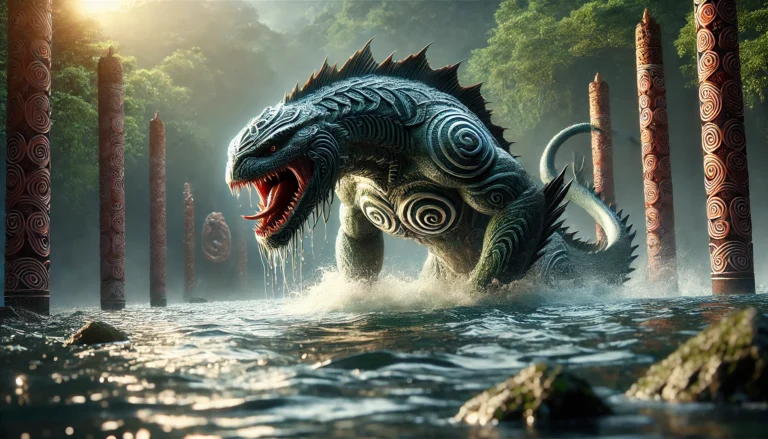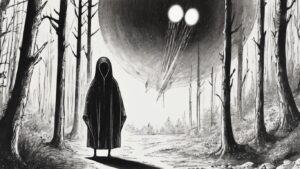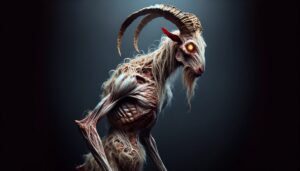Table of Contents
Origins
The Taniwha, deeply rooted in Māori mythology, are formidable water beings considered both protectors and threats. These mythical creatures originate from the indigenous lore of New Zealand’s Māori people. Taniwha inhabit the rivers, lakes, and coastal waters, with their presence marking sacred or dangerous places. In the Māori cosmology, the Taniwha hold a significant place, often acting as kaitiaki (guardians) for specific iwi (tribes) and hapū (sub-tribes). The dual nature of the Taniwha, both as protectors and potential threats, reflects the Māori worldview, where respect for natural forces and the environment is paramount.
Appearance
The physical appearance of Taniwha varies across different tribes and regions, but they are generally depicted as large, powerful, and reptilian creatures. Some descriptions portray Taniwha as gigantic lizards, akin to dragons, with sharp claws and teeth, while others resemble enormous serpents or whales. These variations often reflect the natural features and fauna of the Taniwha’s habitat. For instance, a Taniwha dwelling in a river may have a sinuous, eel-like body, whereas a coastal Taniwha might resemble a monstrous sea creature. Their skin is said to be impenetrable, covered in scales or a thick hide, making them almost invincible. The eyes of a Taniwha are often described as glowing, instilling fear and awe in those who encounter them.
Abilities and Powers
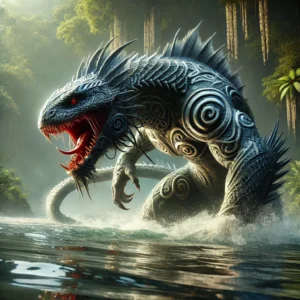
Taniwha possess a range of supernatural abilities, making them formidable entities within Māori mythology. They are known for their immense strength, capable of causing earthquakes, landslides, and other natural disasters. Some Taniwha can manipulate water, creating whirlpools and floods to protect their territories or punish those who disrespect them. Additionally, Taniwha are believed to have the power to shapeshift, allowing them to transform into different forms, including human guise. This ability enables them to interact with humans and play significant roles in various myths and stories.
Weaknesses
Despite their formidable nature, Taniwha are not invincible. Their weaknesses are often tied to the natural elements and the spiritual realm. In some tales, Taniwha can be defeated by skilled warriors or tohunga (spiritual leaders) wielding sacred weapons or invoking powerful incantations. These weapons are often crafted from special materials, imbued with spiritual significance. Additionally, a Taniwha’s connection to a specific place or waterway can be a vulnerability, as disrupting their habitat or severing their spiritual ties can weaken them. However, such actions are fraught with danger and require great respect and understanding of Māori customs and traditions.
Behavior and Interaction with Humans
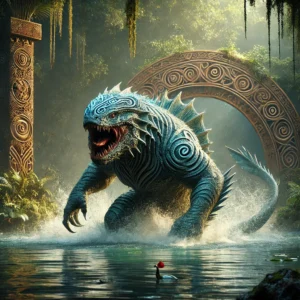
The behavior of Taniwha towards humans varies widely, reflecting their dual nature as both guardians and threats. Some Taniwha are benevolent protectors, safeguarding their tribes and ensuring the well-being of their people. These guardian Taniwha often establish a symbiotic relationship with their communities, receiving offerings and respect in exchange for their protection. For instance, the Taniwha of the Waikato River, known as Waata, is revered by the local tribes for its protective role. In contrast, other Taniwha are vengeful and territorial, punishing those who trespass on their domains or disrespect their sacred places. These hostile Taniwha are often the subjects of cautionary tales, warning against the dangers of disrespecting nature and the spiritual world.
Symbols and Representations
Taniwha are represented in various forms of Māori art and symbolism, reflecting their cultural significance. Carvings of Taniwha adorn meeting houses (wharenui) and other important structures, symbolizing protection and spiritual guardianship. These carvings often feature intricate patterns and designs, showcasing the craftsmanship and artistic heritage of the Māori people. Additionally, Taniwha are depicted in traditional tattoos (tā moko), worn by individuals to signify their connection to these powerful beings. The symbols associated with Taniwha include spirals, waves, and other motifs representing water and the natural world. These symbols serve as reminders of the Taniwha’s presence and the need to respect the environment and its spiritual inhabitants.
Myths and Stories
Numerous myths and stories feature Taniwha, each offering unique insights into their nature and significance. One well-known tale is the story of the Taniwha Kōpua, who resided in the Waikato River. Kōpua protected the local tribes but demanded regular offerings of food and respect. When a group of warriors disrespected Kōpua by polluting the river, the Taniwha unleashed a devastating flood, reminding the people of the need to honor their guardian. Another famous story involves the Taniwha Hotu-Puku, who terrorized the Rotorua region. A brave warrior named Pitaka eventually defeated Hotu-Puku using a specially crafted spear, showcasing the theme of human courage and ingenuity in overcoming supernatural threats.
Related Creatures
Taniwha share similarities with other mythical creatures from different cultures, highlighting common themes in global mythology. For instance, Taniwha can be compared to dragons from various mythologies, such as the Chinese Long or the European dragon. Like Taniwha, these dragons are often guardians of natural elements and possess immense power. Additionally, Taniwha bear resemblances to the Naga of Hindu and Buddhist traditions, serpent-like beings associated with water and protection. These comparisons underscore the universal nature of mythical creatures as embodiments of natural forces and cultural values.
Modern Interpretations
In contemporary times, Taniwha continue to play a significant role in Māori culture and New Zealand society. They are often invoked in discussions about environmental conservation and the protection of sacred sites. The presence of a Taniwha is sometimes cited in legal and political contexts, particularly when planning construction projects that may disrupt natural habitats. This reflects the enduring respect for Taniwha and the Māori worldview that emphasizes the interconnectedness of all life. Moreover, Taniwha feature in modern literature, films, and art, highlighting their continued relevance and the fascination they inspire.
Modern culture:
Movies and Television Series
“The Dead Lands” (2014). This New Zealand action-fantasy film, set in a mythical Maori past, follows the story of Hongi, a young warrior seeking revenge for his father’s murder. While Taniwha themselves do not prominently appear, the film delves deeply into Maori culture and myth, featuring other supernatural elements and providing a glimpse into the spiritual world where Taniwha reside.
“Waka Huia” (1987-Present). This long-running New Zealand documentary series explores various aspects of Maori culture, traditions, and mythology. Several episodes delve into the stories and significance of Taniwha within different iwi (tribes).
Books

“The Bone Tiki” by David Hair (2009). This fantasy novel, part of a series, follows a teenager named Matiu Douglas who finds himself in a parallel world where Maori myths and legends come to life. Moreover, Taniwha are featured as part of this mythical landscape.
“Taniwha” by Robyn Kahukiwa (2007). This children’s book tells the story of a boy named Kiri who discovers that the river near his home is protected by a Taniwha. Furthermore, the narrative explores themes of respect for nature and the spiritual guardianship of Taniwha.
Other Media
“Mauri” (1988). This film by Merata Mita, while not directly focusing on Taniwha, is steeped in Maori culture and spiritual beliefs. It touches upon themes of ancestral guardianship, which are often associated with Taniwha.
FAQ
Where do Taniwha live?
Taniwha are believed to inhabit rivers, lakes, and coastal waters in New Zealand.
What do Taniwha look like?
Taniwha are often described as large, reptilian creatures resembling dragons, serpents, or whales.
Are Taniwha considered good or bad?
Taniwha can be both protectors and threats, depending on the context and their relationship with humans.
What abilities do Taniwha have?
Taniwha possess supernatural abilities, such as immense strength, the power to manipulate water, and the ability to shapeshift.
How can Taniwha be defeated?
Taniwha can be defeated by skilled warriors or spiritual leaders using sacred weapons or powerful incantations.
What role do Taniwha play in Māori culture?
Taniwha are important in Māori culture as guardians of sacred places and symbols of the natural world's power.
Are there modern references to Taniwha?
Yes, Taniwha appear in modern literature, films, and are sometimes mentioned in environmental and cultural discussions in New Zealand.
Can Taniwha shapeshift into human form?
Yes, some stories describe Taniwha as having the ability to transform into human form.
What is one famous Taniwha story?
One famous story is about the Taniwha Kōpua, who protected the Waikato River but punished those who disrespected it.
